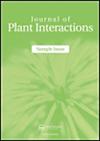不同耐黄萎病橄榄品种的根在酚类和三萜谱上存在数量差异
IF 3.3
3区 生物学
Q2 PLANT SCIENCES
引用次数: 1
摘要
本文章由计算机程序翻译,如有差异,请以英文原文为准。
The roots of olive cultivars differing in tolerance to Verticillium dahliae show quantitative differences in phenolic and triterpenic profiles
ABSTRACT Verticillium wilt of olive (VWO), caused by Verticillium dahliae, is a major concern in many olive-growing countries. An efficient VWO control measure is the use of tolerant/resistant cultivars. Low information is available about olive secondary metabolites and its relationship with VWO tolerance. In this study, a comprehensive metabolic profiling of the roots of six olive cultivars differing in their level of tolerance/susceptibility to VWO was addressed. Potential changes in the metabolite profiles due to the presence of the pathogen were also assessed. A strong relationship between the quantitative basal composition of the root secondary metabolic profile and VWO tolerance/susceptibility of olive varieties was found. Tolerant cultivars showed higher content of secoiridoids, while the susceptible ones presented greater amounts of verbascoside and methoxypinoresinol glucoside. The presence of V. dahliae only caused few significant variations mostly restricted to the earliest times after inoculation. Thus, a rapid activation of biochemical-based root defense mechanisms was observed. Key policy highlights Quantitative differences of secondary metabolites in roots contribute to explain the tolerance/susceptibility of olive cultivars to Verticillium dahliae. Higher basal content of secoiridoids correlate with tolerance, while greater concentration of verbascoside and methoxypinoresinol glucoside seem to be linked to susceptibility. Few alterations are observed in the olive root metabolic profiles in the presence of the pathogen. Changes in the root metabolic profile occur at early times after pathogen inoculation which suggests a rapid activation of a biochemical-based defense response against V. dahliae.
求助全文
通过发布文献求助,成功后即可免费获取论文全文。
去求助
来源期刊

Journal of Plant Interactions
PLANT SCIENCES-
CiteScore
5.30
自引率
6.20%
发文量
69
审稿时长
>12 weeks
期刊介绍:
Journal of Plant Interactions aims to represent a common platform for those scientists interested in publishing and reading research articles in the field of plant interactions and will cover most plant interactions with the surrounding environment.
 求助内容:
求助内容: 应助结果提醒方式:
应助结果提醒方式:


